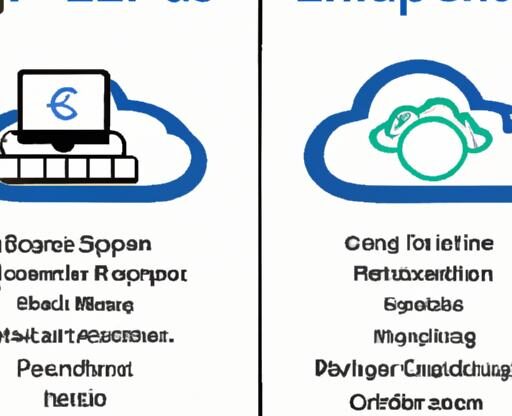Cloud ERP vs On-Premise ERP: Unveiling the Battle of Business Efficiency
Introduction
In the realm of modern enterprise management, the decision to adopt an ERP system is a pivotal one. But with the myriad of options available, it can be overwhelming to choose between Cloud ERP and On-Premise ERP. Let’s embark on a journey to demystify these two approaches and shed light on which one suits your business needs best.
Defining Cloud ERP and On-Premise ERP
Cloud ERP refers to a software solution hosted on remote servers, accessible via the internet. It offers businesses the convenience of accessing critical data and applications from any location, providing a flexible and scalable solution. On the other hand, On-Premise ERP requires hosting the software and data on local servers within the organization’s infrastructure, offering complete control over data and customization options.
The Significance of ERP Systems in Businesses
Before delving deeper into the cloud vs on-premise debate, let’s first understand the importance of ERP systems in modern business operations. ERP systems streamline and integrate various business processes, including finance, human resources, supply chain management, and more. By centralizing data and automating workflows, ERP systems enhance efficiency, productivity, and decision-making capabilities.
By acknowledging the vital role ERP systems play in driving business success, we can now explore the nuances of Cloud ERP and On-Premise ERP. Stay tuned as we uncover the advantages, differences, and considerations for each approach.
Understanding Cloud ERP
What is Cloud ERP?
Cloud ERP is a modern business management solution that operates on remote servers, eliminating the need for on-premise infrastructure. With Cloud ERP, businesses can access their data and applications securely through the internet, making it a convenient and efficient choice for organizations of all sizes.
Advantages of Cloud ERP
Scalability and Flexibility
One of the key advantages of Cloud ERP is its scalability and flexibility. As your business grows, Cloud ERP allows you to easily scale up your operations without worrying about hardware limitations. Whether you need to add more users, expand storage capacity, or integrate new modules, Cloud ERP provides the flexibility to adapt to your changing business needs.
Cost-Effectiveness
Cloud ERP offers cost-effective solutions for businesses. By eliminating the need for on-premise infrastructure and the associated maintenance costs, businesses can significantly reduce their upfront investment. Additionally, Cloud ERP operates on a subscription-based model, allowing you to pay for the services you need and scale accordingly, making it a more affordable option for businesses with limited budgets.
Accessibility and Mobility
With Cloud ERP, you can access your business data and applications from anywhere, anytime, as long as you have an internet connection. This accessibility and mobility empower remote teams, field workers, and businesses with multiple locations to collaborate seamlessly. The ability to access real-time data and make informed decisions on-the-go enhances productivity and agility.
Automatic Updates and Maintenance
Cloud ERP providers take care of system updates, upgrades, and maintenance tasks, ensuring that your software is always up-to-date and running smoothly. This relieves businesses of the burden of managing and maintaining their ERP systems, allowing them to focus on core operations. Automatic updates also ensure that you benefit from the latest features, security enhancements, and compliance requirements without any disruptions.
In the next section, we will dive into On-Premise ERP to understand its features and advantages. Stay tuned to unravel the intricacies of this traditional approach to ERP systems.
Exploring On-Premise ERP
On-Premise ERP refers to a traditional approach where the software and data are housed within an organization’s own servers and infrastructure. This means that the organization assumes complete responsibility for the management, maintenance, and security of the ERP system.
Definition and Explanation of On-Premise ERP
Unlike Cloud ERP, On-Premise ERP is installed locally on the organization’s servers and computers. It provides businesses with full control and ownership over their ERP system, allowing them to customize and tailor it to their specific needs. With On-Premise ERP, organizations can directly manage their data and have the flexibility to make adjustments as their business evolves.
Advantages of On-Premise ERP
Data Control and Security
One of the primary advantages of On-Premise ERP is the level of control it offers over sensitive data. Since the data resides within the organization’s infrastructure, there is a heightened sense of security and control. This is particularly crucial for businesses operating in highly regulated industries or those with stringent data privacy requirements.
Customization Options
On-Premise ERP provides businesses with extensive customization capabilities. Organizations can tailor the system to match their unique workflows, processes, and reporting requirements. This level of customization ensures that the ERP system aligns perfectly with the organization’s needs, maximizing its effectiveness and efficiency.
Offline Accessibility
Another benefit of On-Premise ERP is the ability to access the system and critical data even without an internet connection. This is particularly advantageous for businesses operating in remote areas or those facing unreliable internet connectivity. With On-Premise ERP, employees can continue their work uninterrupted, regardless of the availability of internet access.
As we journey through the comparison between Cloud ERP and On-Premise ERP, we will next explore the key differences between these two approaches. Stay tuned to discover which ERP system is the best fit for your organization’s unique needs.
Key Differences between Cloud ERP and On-Premise ERP
When it comes to choosing between Cloud ERP and On-Premise ERP, understanding the key differences is crucial in making an informed decision. Let’s explore the factors that set these two approaches apart.
Deployment and Infrastructure
Cloud ERP eliminates the need for on-premise servers and infrastructure, as the software is hosted on remote servers. This means you can avoid the costs and complexities associated with maintaining hardware and managing upgrades. On the other hand, On-Premise ERP requires on-site servers and infrastructure, requiring dedicated IT resources for installation, maintenance, and updates.
Cost Comparison
Cloud ERP typically follows a subscription-based pricing model, where you pay for the services you use. This allows for scalability and flexibility, as you only pay for what you need. In contrast, On-Premise ERP involves higher upfront costs, including software licenses, server hardware, and IT infrastructure. However, over time, the costs of Cloud ERP may surpass those of On-Premise ERP if your business scales rapidly.
Data Security and Control
One of the primary concerns for businesses is data security and control. With Cloud ERP, data is stored on remote servers, managed and secured by the service provider. While reputable providers implement robust security measures, some businesses may prefer the added control and security of On-Premise ERP, where data resides within their own premises and under their direct supervision.
Customization and Flexibility
Cloud ERP systems often offer limited customization options, as they aim to cater to a broader user base. On the other hand, On-Premise ERP allows for extensive customization, enabling businesses to tailor the system to their specific needs. This level of customization can be advantageous for industries with unique requirements or complex workflows.
Accessibility and Mobility
Cloud ERP provides unmatched accessibility and mobility, allowing users to access the system and data from anywhere with an internet connection. This enables remote work, collaboration, and real-time decision-making. On the contrary, On-Premise ERP may limit accessibility to on-site or VPN-connected devices, which can hinder productivity and flexibility in today’s dynamic business environment.
By understanding these key differences, you can better evaluate which ERP approach aligns with your business goals, budget, and operational requirements. Stay tuned as we delve into the considerations that should guide your decision-making process.
Considerations for Choosing the Right ERP System
When it comes to selecting the right ERP system for your business, several crucial factors must be taken into account. Let’s explore the key considerations that can help you make an informed decision.
Business Size and Scalability Needs
The size of your business plays a significant role in determining the ideal ERP solution. Cloud ERP offers unparalleled scalability, allowing businesses to easily adjust resources and accommodate growth. Small and medium-sized enterprises (SMEs) often find Cloud ERP more cost-effective and flexible, whereas larger enterprises with extensive IT infrastructure may opt for On-Premise ERP for greater control and customization options.
Budget Considerations
Financial considerations are paramount when evaluating ERP systems. Cloud ERP typically involves subscription-based pricing models, offering cost savings through reduced upfront investment and maintenance costs. On the other hand, On-Premise ERP often requires substantial upfront investment, including hardware, licenses, and ongoing maintenance expenses. Assessing your budgetary constraints is crucial to ensure a solution that aligns with your financial capabilities.
IT Infrastructure and Resources
Evaluating your existing IT infrastructure and resources is vital in determining the compatibility of an ERP system. Cloud ERP requires a stable internet connection and relies on the vendor’s infrastructure, making it less resource-intensive for businesses without extensive IT capabilities. Conversely, On-Premise ERP necessitates robust internal IT resources, including hardware, networking, and dedicated IT personnel for maintenance and support.
Data Security Requirements
Data security is a paramount concern for businesses operating in today’s digital landscape. Cloud ERP providers employ advanced security measures, including encryption, data backups, and secure data centers, ensuring protection against cyber threats. However, if your business handles highly sensitive data or operates in industries with strict compliance requirements, On-Premise ERP may offer better control over data security, as it allows you to manage and safeguard data within your own infrastructure.
Compliance and Industry Regulations
Different industries have specific regulatory requirements that must be met. Compliance considerations, such as data privacy laws or industry-specific regulations, can significantly influence your ERP selection. It is crucial to assess whether the chosen ERP system aligns with the compliance standards of your industry and provides necessary features to meet regulatory requirements.
By carefully considering these factors, you can make an informed decision that aligns with your business’s unique needs, ensuring the selected ERP system effectively supports your operations and growth trajectory.
Conclusion
After exploring the differences between Cloud ERP and On-Premise ERP, it’s clear that each approach offers distinct advantages and considerations.
Cloud ERP provides businesses with the flexibility, scalability, and cost-effectiveness they need in today’s dynamic and fast-paced environment. With automatic updates and maintenance, accessibility from anywhere, and the ability to scale resources as needed, Cloud ERP proves itself as a reliable solution for businesses of all sizes.
On the other hand, On-Premise ERP offers unparalleled control over data and customization options. It is ideal for organizations that prioritize data security, have complex integration requirements, or operate in industries with stringent compliance regulations.
When making a decision between Cloud ERP and On-Premise ERP, it is crucial to consider factors such as the size and scalability needs of your business, budget considerations, available IT infrastructure, and data security requirements. Evaluating these aspects will help you make an informed decision that aligns with your unique business needs.
As technology continues to advance, ERP systems will undoubtedly play a pivotal role in optimizing business operations. Whether you choose to embrace the flexibility of the cloud or the control of on-premise, it’s important to remember that the success of your ERP implementation ultimately depends on selecting the right system for your organization.
In conclusion, both Cloud ERP and On-Premise ERP have their merits, and the choice ultimately depends on your specific business requirements. By understanding the advantages and considerations of each approach, you can make an informed decision that sets your business on the path to greater efficiency, productivity, and success.
Remember, whether you choose the ethereal clouds or the solid ground of an on-premise solution, what matters most is how well your chosen ERP system aligns with your business goals. So, take your time, evaluate your needs, and embark on the journey towards ERP bliss with confidence.





